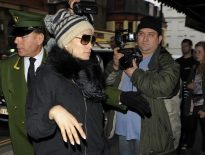The world’s oldest undeciphered writing system, which has so far defied attempts to uncover its 5,000-year-old secrets, could be about to be decoded by Oxford University academics.
This international research project is already casting light on a lost bronze age middle eastern society where enslaved workers lived on rations close to the starvation level.
“I think we are finally on the point of making a breakthrough,” says Jacob Dahl, fellow of Wolfson College, Oxford and director of the Ancient World Research Cluster.
Dr Dahl’s secret weapon is being able to see this writing more clearly than ever before.
In a room high up in the Ashmolean Museum in Oxford, above the Egyptian mummies and fragments of early civilisations, a big black dome is clicking away and flashing out light.
This device, part sci-fi, part-DIY, is providing the most detailed and high quality images ever taken of these elusive symbols cut into clay tablets. This is Indiana Jones with software.
It’s being used to help decode a writing system called proto-Elamite, used between around 3200BC and 2900BC in a region now in the south west of modern Iran.
And the Oxford team think that they could be on the brink of understanding this last great remaining cache of undeciphered texts from the ancient world.
Tablet computer
Dr Dahl, from the Oriental Studies Faculty, shipped his image-making device on the Eurostar to the Louvre Museum in Paris, which holds the most important collection of this writing.
The clay tablets were put inside this machine, the Reflectance Transformation Imaging System, which uses a combination of 76 separate photographic lights and computer processing to capture every groove and notch on the surface of the clay tablets.
It allows a virtual image to be turned around, as though being held up to the light at every possible angle.
These images will be publicly available online, with the aim of using a kind of academic crowdsourcing.
He says it’s misleading to think that codebreaking is about some lonely genius suddenly understanding the meaning of a word. What works more often is patient teamwork and the sharing of theories. Putting the images online should accelerate this process.
But this is painstaking work. So far Dr Dahl has deciphered 1,200 separate signs, but he says that after more than 10 years study much remains unknown, even such basic words as “cow” or “cattle”.
He admits to being “bitten” by this challenge. “It’s an unknown, uncharted territory of human history,” he says.
Extinct language
But why has this writing proved so difficult to interpret?
Dr Dahl suspects he might have part of the answer. He’s discovered that the original texts seem to contain many mistakes – and this makes it extremely tricky for anyone trying to find consistent patterns.
He believes this was not just a case of the scribes having a bad day at the office. There seems to have been an unusual absence of scholarship, with no evidence of any lists of symbols or learning exercises for scribes to preserve the accuracy of the writing.
This first case of educational underinvestment proved fatal for the writing system, which was corrupted and then completely disappeared after only a couple of hundred years. “It’s an early example of a technology being lost,” he says.
“The lack of a scholarly tradition meant that a lot of mistakes were made and the writing system may eventually have become useless.”
Making it even harder to decode is the fact that it’s unlike any other ancient writing style. There are no bi-lingual texts and few helpful overlaps to provide a key to these otherwise arbitrary looking dashes and circles and symbols.
This is a writing system – and not a spoken language – so there’s no way of knowing how words sounded, which might have provided some phonetic clues.
Dr Dahl says that one of the really important historical significances of this proto-Elamite writing is that it was the first ever recorded case of one society adopting writing from another neighbouring group.
But infuriatingly for the codebreakers, when these proto-Elamites borrowed the concept of writing from the Mesopotamians, they made up an entirely different set of symbols.
Why they should make the intellectual leap to embrace writing and then at the same time re-invent it in a different local form remains a puzzle.
But it provides a fascinating snapshot of how ideas can both spread and change.
Mr One Hundred
In terms of written history, this is the very remote past. But there is also something very direct and almost intimate about it too.
You can see fingernail marks in the clay. These neat little symbols and drawings are clearly the work of an intelligent mind.
These were among the first attempts by our human ancestors to try to make a permanent record of their surroundings. What we’re doing now – my writing and your reading – is a direct continuation.
But there are glimpses of their lives to suggest that these were tough times. It wasn’t so much a land of milk and honey, but porridge and weak beer.
Even without knowing all the symbols, Dr Dahl says it’s possible to work out the context of many of the messages on these tablets.
The numbering system is also understood, making it possible to see that much of this information is about accounts of the ownership and yields from land and people. They are about property and status, not poetry.
This was a simple agricultural society, with a ruling household. Below them was a tier of powerful middle-ranking figures and further below were the majority of workers, who were treated like “cattle with names”.
Their rulers have titles or names which reflect this status – the equivalent of being called “Mr One Hundred”, he says – to show the number of people below him.
It’s possible to work out the rations given to these farm labourers.
Dr Dahl says they had a diet of barley, which might have been crushed into a form of porridge, and they drank weak beer.
The amount of food received by these farm workers hovered barely above the starvation level.
However the higher status people might have enjoyed yoghurt, cheese and honey. They also kept goats, sheep and cattle.
For the “upper echelons, life expectancy for some might have been as long as now”, he says. For the poor, he says it might have been as low as in today’s poorest countries.
The tablets also have surprises. Even though there are plenty of pictures of animals and mythical creatures, Dr Dahl says there are no representations of the human form of any kind. Not even a hand or an eye.
Was this some kind of cultural or religious taboo?
Dr Dahl remains passionate about what this work says about such societies, digging into the deepest roots of civilisation. This is about where so much begins. For instance, proto-Elamite was the first writing ever to use syllables.
If Macbeth talked about the “last syllable of recorded time”, the proto-Elamites were there for the first.
And with sufficient support, Dr Dahl says that within two years this last great lost writing could be fully understood.
Would you like to help with this effort to decipher this writing? Send us your comments
Allow me to be the 967th person to translate this to read “Hello, Sweetie!”
Mark, Durham, New Hampshire
Sounds fascinating. All I’ve done in this area is trying to decipher the words on 120 year old land grants for this area, but the problem was quality of the images. It appears that may not be a problem here
Peter Vander Sar, Canada
I am fascinated by this article and the attempt to decipher the tablets so would very much like to help.
Susan Merkeley, British Columbia, Canada
It might help, if comparative (pre) Zorastrian phonetic basics are adopted
Anil A. Vyas, Pune, India
Being an agrarian community it’s possible that the phases of the moon might also be mentioned re planting cycles though I’m sure that has already been thought about by the deciphering team.
Sarah Waldock, Ipswich
I am currently studying Classics at UCL, and so anything to do with ancient scripts or writing is so interesting, congratulations to Dr. Dahl for all his hard working paying off!
Fiona, London
Sounds a fascinating and intriguing problem. It would be great to contribute, even if only in some small way, to finding the solution.
Simon, Derbyshire
What a great article! More of this please BBC
Simon, London
This is a problem tailor made for the boffins at GCHQ Cheltenham. Let them do something interesting in their spare time. There must be lots of computer + brain power there. Alternatively, or additionally, there may still be some oldies from Bletchley Park who would like to have a go.
Peter Crawford, Banbury
Now this is one of the most fascinating articles I have read for a long time. I dearly hope that there is a documentary going to be made out of this as it may , just may, unlock an unknown understanding of how we all work.
David Ford, Cheshire
This sounds like something that would really intrigue some of my students – I am a secondary teacher of MFL – would we be able to get involved please?
Hannah Ryan, Hythe, Kent
Having studied anthropology and linguistics , I would love to try and help solve the mystery of this cipher. No guarantees though! As I live on a South Sea island with few diversions or entertainment, it would certainly be a privilege and challenge to try and help Dr. Dahl with the code.
Helga Saint-Pierre, New Caledonia
Simply fascinating! I would very much like to help in any way that I can with the ongoing project of deciphering the writings of the Proto-Elamites
Dr Giles Hodgskins, British Army (BFG)
So fascinating! Could the representation of cattle (horns) be also the representation of man/god or taboo divinity ? Could it be linked to the reason why the old testament starts with beta and not aleph (horn)?
Caroline, Bath
I know what this is- Its a shopping list and DIY request from a wife for husband, who has “lost”it on the way after a few barley wines. Domestic life really has not changed that much!
David Buxton, Hampshire
It quite clearly says “Take two paracetamol every six hours, with plenty of fluids, and if symptoms persist, come back to the surgery in a couple of days.”
Keiron Marsden, Bristol
The attorney general has finally published Prince Charles’s 27 letters to government ministers.
Mista C,
Would be very interested in helping in way possible. I am no Champollion or Ventris and it looks as though there is a corpus that would mean it is more possible than the Phaistos Disc. Application of AI/ANN as mentioned by a previous poster will not work as it will potentially show a pattern, but nothing to match that pattern against. What is interesting is that there are potential errors in the text. Probably most things have been tried however my thoughts are that the errors might give an in road. Analyse the distribution of the errors using known translations and where symbols are known to be replaced. Then map the statistical anomaly to the unknown pieces of text generating a candidate true text by substituting potential “correct” symbols. Then using the candidate text, see if there are more symbols resolved than in the original. View the highest resolved texts to see if they make sense in the context.
Richard C, Harpenden
I’m looking forward to seeing or reading about how this gets broken. The story of the heiroglyphics breakthrough – where the cartouches were identified as known names and it all flowed from there was a treat. Maybe something similar will provide a breaktrhough here.
Sandy Fox, Derby
Considering that this was a simple agricultural society,where life for the average worker would be short,could this not be a manual/diary of agricultural practices and seasons? This could then be left for surviving members of the community to contiue with what was considered good husbandry.Presumably a record of astrological movements and religious festivals could have also been recorded.
Dan, Spain
I would be interested in helping studying the script. I am a Phd student in formal logic, so perhaps i could contribute something in the way of deciphering relevant patterns.
Riccardo, Amsterdam
I’m 99% sure that someone has thought of this already, but what about using some sort of Artificial Intelligence approach, such as an unsupervised Neural Network for pattern recognition?
Mike Overhill-Smith, York
I would like to congradulate Dr. Dahl & BBC for this fascinating findings. Since I came from (Sumerian and Acadian) Mesopotamian origin. I would like to add some measures like: the size of the symbols and the repeatability of these codes in comparison with Mesopotamian writings which might find some sort of pattern. I agree with Sarah Waldock, Ipswich about it could refer to replanting cycles (Crescent for moon and dots for workers required to do the plantation..etc) as the decipher team might already knows that. Good luck
Dr Safa Ramadaan, Buckinghamshire






